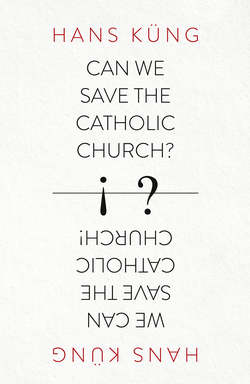Читать книгу Can We Save the Catholic Church? - Hans Kung - Страница 30
Оглавление
Whether academic or popular, criticism of the Church often lacks historical depth. Some things are described as ‘fundamentally Catholic’, even if they developed during a later stage of Catholicism, and, conversely, other things are dismissed as being utterly ‘non-Catholic’ even though they had been present from the beginning and existed for centuries. What is urgently required, therefore, is a well-founded historical analysis that can shed more light on the matter.
To make an accurate diagnosis of an illness, one must not merely look at the symptoms; one must get to the causes. A diagnosis of the Church’s illness, therefore, must take into account the most recent scientific research: Catholic and non-Catholic historians alike now agree on many points that were once debated between Catholic apologists and non-Catholic critics. The no-longer-contested findings of modern historians make uncomfortable reading for the Roman Curia and their supporters, and so they continue to ignore them, not just in theory but also in practice, a fact eloquently documented by the many unheard, historically well-founded demands for reform. Hence, a comprehensive anamnesis – a re-membering – of the Church’s history, seeking to understand the origins and development of the Church’s illness, is imperative. Without such an anamnesis there is no question of a cure.
During my years as a student in Rome, I dutifully listened as a tame, domesticated history of the Roman Catholic Church was recounted, and this left me unsatisfied. Since my early days as a young professor, I have repeatedly turned my attention to historical studies. My long project of anamnesis is reflected and documented, with abundant references and concrete details, in many of my books.
Many conservative readers, after reading this highly critical book, will no doubt object that I have not dealt with the positive sides of the Church, but the positive aspects of the Catholic Church have all been set forth at length in my previous books. To repeat them here would only distract from the problem at hand. In particular, my book The Church, published over forty-five years ago, is still considered topical and relevant and, translated into many different languages, is still used as a classic textbook in universities today. My books Christianity: Its Essence and History (1995) and The Catholic Church: A Short History (2001) present detailed, systematic accounts of the Catholic Church’s overall historical development. The present book, therefore, does not deal with the history of the Church in general, but with the Church’s specific medical history, and the causes of the illness of the Church. As already discussed, I will concentrate here on problems with the Church’s constitution and with the central Roman institution of power, the papacy.
It is time to investigate a long and chequered history. Let us start at the beginning.
